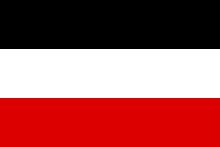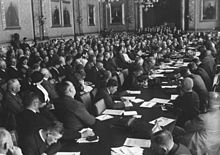
Back حزب الشعب الوطني الألماني Arabic حزب الشعب الوطنى الالمانى ARZ Нямецкая нацыянальная народная партыя Byelorussian DNVP BS Partit Nacional del Poble d'Alemanya Catalan Německá národně lidová strana Czech Deutschnationale Volkspartei Danish Deutschnationale Volkspartei German Γερμανικό Εθνικό Λαϊκό Κόμμα Greek German National People's Party English


Le Parti populaire national allemand[29],[30],[31],[32] (ou Parti national du peuple allemand ; en allemand Deutschnationale Volkspartei, généralement abrégé en DNVP) était un parti politique allemand situé entre la droite et l'extrême droite à l'époque de la république de Weimar.
Parfois présenté comme appartenant à la tendance « nationale-conservatrice » et composante importante du mouvement dit de la « Révolution conservatrice », le DNVP reprenait en grande partie, mais en les radicalisant, les cadres et les fondements idéologiques de l'ancien Parti conservateur allemand, actif sous l'Empire allemand. Jusqu'à l'ascension du Parti national-socialiste des travailleurs allemands (NSDAP), le DNVP, proche de la Ligue pangermaniste ainsi que des anciens combattants du Stahlhelm, représentait le principal parti völkisch[33]. Antisémite, il exclut officiellement, en 1929, les Juifs du parti[34]. L'historien Ian Kershaw souligne son rapport ambigu avec l'extrême-droite : si le DNVP était völkisch, antisémite et partageait, selon Kershaw, nombre de « caractéristiques fascistes », il se définissait toutefois davantage comme conservateur, voire aristocrate et élitiste, que comme populiste[35].
- Hertzman, Lewis (1958). The Founding of the German National People's Party (DNVP), November 1918-January 1919 pp. 24–36
- Kolb, Eberhard. The Weimar Republic, London: Unwing Hyman, 1988, p. 75.
- Beck, Hermann (2009). The Fateful Alliance: German Conservatives and Nazis in 1933: The Machtergreifung in a New Light pp. 50–51
- Hadry, Sarah (2007). German Fatherland Party (DVLP), 1917/18; "Party leaders and assets were transferred to the German National People's Party."
- Heinrich, August (2008). Germany: The Long Road West, 1789–1933 p. 352
- Larry Eugene Jones, The German Right in the Weimar Republic: Studies in the History of German Conservatism, Nationalism, and Antisemitism, Berghahn Books, 2014, p. 80
- Heinrich August Winkler, Germany: The Long Road West, 1789–1933, Oxford University Press, , p. 352
- Nazis Outlaw Nationalists As Rival Party, "Milwaukee Sentinel", June 28, 1933, p. 2
- Beck, Hermann (2009). The Fateful Alliance: German Conservatives and Nazis in 1933: The Machtergreifung in a New Light p. 26
- Foster, Frances (1996). The press of the Weimar Republic and its representation in German literature pp. 9–10
- Wistrich, Robert (1984). Who's Who in Nazi Germany, p. 157
- Larry Eugene Jones et James Retallack, Introduction, Cambridge University Press, , p. 11
- Matthew Stibbe, Germany, 1914–1933 : Politics, Society and Culture, Pearson Education, , p. 212
- Peter C. Caldwell, Popular Sovereignty and the Crisis of German Constitutional Law : The Theory & Practice of Weimar Constitutionalism, Duke University Press, , p. 74
- Peter C. Caldwell, The Citizen and the Republic in Germany, 1918–1935 : Citizenship and National Identity in Twentieth-Century Germany, Stanford University Press, , p. 48
- Ulrike Ehret, Church, Nation and Race: Catholics and Antisemitism in Germany and England, 1918-45, Manchester University Press, (ISBN 978-1-84779-452-9, lire en ligne), « The Catholic right, political Catholicism and radicalism: the Catholic right in Germany »
- Seymour M. Lipset, "Social Stratification and 'Right-Wing Extremism'" British Journal of Sociology 10#4 (1959), pp. 346-382 on-line
- Fritz K. Ringer, The Decline of the German Mandarins : The German Academic Community, 1890–1933, University Press of New England, , p. 201
- Eric D. Weitz, Weimar Germany: Promise and Tragedy. (Princeton: Princeton University, 2007), 95–96.
- Bauer, Yehuda Rethinking the Holocaust, New Haven: Yale University Press, 2000 page 101.
- Hertzman, Lewis DNVP Right-wing Opposition in the Weimar Republic, 1918–1924, Lincoln: University of Nebraska Press, 1963 page 137.
- Hertzman, Lewis "The Founding of the German National People's Party (DNVP), November 1918–January 1919" pages 24–36 from The Journal of Modern History, Volume 30, Issue #1, March 1958 page 31.
- Martin Kitchen, Europe Between the Wars : A Political History, Pearson Education, , p. 249
- (de) Boris Barth, Genozid : Völkermord im 20. Jahrhundert : Geschichte, Theorien, Kontroversen, C. H. Beck, , p. 176
- Beck, Hermann. The Fateful Alliance: German Conservatives and Nazis in 1933 Oxford: Berghahn Books, 2009 p. 55
- Nancy R. Reagin, Sweeping the German Nation: Domesticity and National Identity in Germany Germany, 1870–1945, Cambridge University Press, , p. 106
- R. Eatwell, Fascism: A History, London: Pimlico, 2003, p. 277
- Peter Dudek et Hans-Gerd Jaschke, Entstehung und Entwicklung des Rechtsextremismus in der Bundesrepublik, vol. 1, Westdeutscher Verlag, , 181–201 p.
- Stefan Breuer, Anatomie de la Révolution conservatrice, Paris, Éd. de la Maison des sciences de l'homme, 1996, p. 138.
- Manfred Kittel, « Le Zentrum et les protestants sous la république de Weimar » dans Sylvie Guillaume et Jean Garrigues (dir.), Centre et centrisme en Europe aux XIXe et XXe siècles, Bruxelles, Peter Lang, 2006, p. 86.
- Gerd Krumeich, « L'impossible sortie de guerre de l'Allemagne », dans Stéphane Audoin-Rouzeau, Christophe Prochasson (dir.), Sortir de la Grande Guerre. Le monde et l'après 1918, Paris, Tallandier, 2008, p. 159.
- Hans Mommsen, Le national-socialisme et la société allemande. Dix essais d'histoire sociale et politique, Paris, Éd. de la Maison des sciences de l'homme, 1997, p. 405.
- George L. Mosse, Les racines intellectuelles du IIIe Reich, trad. chez Points, 2006, p. 359-411
- George L. Mosse, Les racines intellectuelles du IIIe Reich, trad. chez Points, 2006, p. 394
- Ian Kershaw, « Ideology, Propaganda, and the Rise of the Nazi Party », pages 162-181 in The Nazi Machtergreifung, dir. Peter Stachura, London : George Allen, 1983.
© MMXXIII Rich X Search. We shall prevail. All rights reserved. Rich X Search
